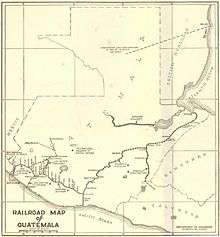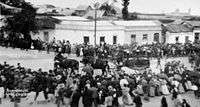José María Orellana
José María Orellana Pinto (July 11, 1872 – September 26, 1926) was a political and military leader in Guatemala. He was chief of staff of President Manuel Estrada Cabrera and President of Guatemala between 1921 and 1926, after overthrowing Conservative Unionist President Carlos Herrera. During his rule the Quetzal was established as the currency of Guatemala. Orellana Pinto died under suspicious circumstances in 1926 at the age of fifty-four.[1] He was buried in the Guatemalan capital with state honors.
His Excellency General of Division José María Orellana Pinto | |
|---|---|
 José María Orellana's portrait in 1925 | |
| President of the Republic of Guatemala | |
| In office 10 December 1921 – 26 September 1926 | |
| Preceded by | Carlos Herrera |
| Succeeded by | Lázaro Chacón González |
| 16th First Vice President of Guatemala | |
| In office December 8, 1921 – April 28, 1922 | |
| President | Carlos Herrera y Luna |
| Preceded by | José Ernesto Zelaya |
| Succeeded by | Jorge Ubico |
| Personal details | |
| Born | July 11, 1872 El Jícaro, El Progreso, Guatemala |
| Died | September 26, 1926 (aged 54) Antigua Guatemala |
| Military service | |
| Nickname(s) | Don Chema Rapadurero |
| Allegiance | |
| Rank | general |
Early life
José María Orellana Pinto was born in El Jícaro; he was the son of Esteban Orellana and Leonora Pinto. Orellana had a military career becoming General of the Guatemalan Army. He was elected to the Guatemalan legislature on several occasions, as a member of the Liberal Party, and was also Chief of Staff of the President Estrada Cabrera; when serving as such, on April 29, 1907, he was riding alongside the president's coach when the latter suffered a bomb attack -which had been planned by the brothers Avila Echeverría and some of their relatives and friends-. Miraculously, both the president and Orellana were unharmed by the assassination attempt and almost immediately initiated the prosecution of the perpetrators.[2]
Coup d'état against Carlos Herrera

On December 5, 1921, general Orellana -sponsored by the United Fruit Company- lead a coup d'état against president Carlos Herrera who had resisted to approve the concessions granted to the United Fruit Company and its subsidiaries by his predecessor, Manuel Estrada Cabrera. Orellana had the help of several army officers, among them general Jorge Ubico.[3]
Presidency
On December 5, 1921, Orellana was appointed as Interim President, and eventually became Constitutional President after winning the elections the following year. During his term in office, he ratified concessions that the government of Estrada Cabrera had made to the United Fruit Company (UFCO) and that Herrera had refused to ratify. He also encouraged the creation of a tripartite republic formed by Guatemala, Honduras and El Salvador, but this was unsuccessful. In 1923, in celebration of the birth centennial of liberal writer and ideologist Dr. Lorenzo Montúfar y Rivera, the government erected a monument to his memory in Avenida Reforma.
Economy
Gum raw material extraction in the northern department of Petén was sold to Percy W. Shufeldt, who carried out the operation without paying taxes; unlike his predecessor—Carlos Herrera—Orellana gave favorable contracts such as the Shufeldt one to foreign companies. Another examples was the Electric Company, which had been expropriated from German shareholders after World War I, and was sold to the American Bond and Share Company on May 4, 1922.

Orellana promoted the construction of hundreds of kilometers of railways and was pressured by the International Railways of Central America[Note 1] to enforce the Méndez-Williamson railroad contract, signed in 1908 by then president Manuel Estrada Cabrera. When Estrada Cabrera was ousted, IRCA had intended to enact this agreement but the acting president Carlos Herrera refused to implement the contract;[Note 2] after Herrera was overthrown, Orellana ratified the contract on March 10, 1922.[4]
The Guatemalan Congress issued the following laws during his term in office:
- Ratified the Central American Union Covenant held in San Jose, Costa Rica.
- Approved the contract for light, heat and electric power services, held in Guatemala City between government representatives and the Central America Power Company.
- Hydrocarbons law
- Ratified executive Decree 798, by which Archbishop Luis Javier Muñoz y Capurón remained in exile.
- Approved the contract between the government and Emilio Capoulliez, proxy for Washington Serruys, for the installation of an electric tram.
- Approved the contract between the Ministry of Development and the All America Cables Incorporated company to build a public telegram office in Guatemala City
- Approved the contract with AEG from Berlin, Germany, to continue and complete the Los Altos Railway and the Santa María power plant.
- Approved oil exploration contracts with US companies.
- Work Act
- Endorsed and encourage a national soap industry development.[4]
The United Fruit Company
- Dockworkers strike: In mid-1924, Puerto Barrios workers -key to banana transport- demanded an 8-hour day and increased wages. When UFCO refused to accept, workers went on strike, with the support from all workers in the farms of the frutera. UFCO asked the Guatemalan government for help, and Orellana quickly sent troops to restore order in Puerto Barrios; the collision was brutal and resulted in numerous workers injured or dead. The strike lasted 27 days, but repression tactics finished it: 22 leaders were jailed and then expelled from the country.[3]
- Railroad strike : In late 1924, the employees of International Railways of Central America (IRCA) demanded the reduction of working hours, higher wages and respect to their labor union. Railway Society. Again, the frutera flatly refused to accept these demands and ordered Orellana's government to violently repress the strike of five thousand workers.[3]
Cultural references
- Rafael Arevalo Martinez talks about Orellana in numerous occasions in his biography of Estrada Cabrera ¡Ecce Pericles!.
- Orellana is also mentioned, though not by name, in the Guatemalan novels El Señor Presidente, Viernes de Dolores and Viento Fuerte of Nobel Laureate Miguel Angel Asturias. In Viernes de Dolores, Asturias calls Orellana by his nickname: Rapadurero.[Note 3]
- Given that during his rule the Quetzal was instituted as the Guatemalan currency, his image appears on the one quetzal bills, which are colloquially called "chemas".[Note 4]
- His cousin, general Manuel María Contreras Orellana later would lead a coup against interim president Baudilio Palma in December 1930.[5]

Death

On 25 May 1926, El Imparcial -a private newspaper- had published a news flash: Martial law enacted which referred to executive decree 916, in which President Orellana had suspended the individual guarantees contained in the Constitution; the main reason for such decision was that "insidious and unpatriotic activities of certain elements" tended "to disrupt the peace and development of the country", which, at once, made it impossible to solve the national economic problem. Although El Imparcial was not circulating regularly in the previous days -due to a government boycott-, after May 26 it ceased publication indefinitely. Thereafter, only the official news outlets, such as Diario de Centro América and El Guatemalteco, could circulate, carrying irrelevant information.[6] The story took a sudden turn on Sunday September 26, when, at 0:15 pm, Orellana died during a vacation trip to Antigua Guatemala; he was in a room at Hotel Manchén. "A violent angina attack ended the life of our illustrious president," explained Diario de Centro America in a special edition that day.[6] These strange circumstances led to the suspicion that he was poisoned.[1] General Lázaro Chacón assumed as interim President and immediately lifted Martial Law and allowed private newspaper to be published again.[6]
References
| Wikimedia Commons has media related to José María Orellana. |
| Wikimedia Commons has media related to United Fruit Company. |
- Hernández de León 1930a.
- Arévalo Martínez 1945, p. 178.
- Bauer Paz 1965.
- Molina C. 2011.
- Hernández de León 1930, p. December 17.
- Villalobos Viato 2013.
Bibliography
- Arévalo Martínez, Rafael (1945). ¡Ecce Pericles! (in Spanish). Guatemala: Tipografía Nacional.CS1 maint: ref=harv (link)
- Asociación de Amigos del País (2004). Diccionario histórico biográfico de Guatemala (in Spanish) (1st ed.). Guatemala: Amigos del País, Fundación para la Cultura y el Desarrollo. ISBN 99922-44-01-1.CS1 maint: ref=harv (link)
- Asturias, Miguel Ángel (1978). Viernes de Dolores (in Spanish). Buenos Aires: Lozada.CS1 maint: ref=harv (link)
- Bauer Paz, Alfonso (1965). Compilación de leyes laborales de Guatemala de 1872 a 1930 (in Spanish). Guatemala: Centro de Estudios Económicos y Sociales, University of San Carlos of Guatemala.CS1 maint: ref=harv (link)
- Fuentes Oliva, Regina (September 2012). "1920, una década de cambios educativos para Guatemala". Boletín AFEHC (in Spanish) (54). Retrieved 1 December 2014.CS1 maint: ref=harv (link)
- Hernández de León, Federico (December 1930). "Golpe de Estado contra presidente Baudilio Palma". Nuestro Diario (in Spanish). Guatemala.CS1 maint: ref=harv (link)
- Hernández de León, Federico (1930a). El Libro de las Efemérides (in Spanish). Guatemala: Tipografía Sánchez y de Guise.CS1 maint: ref=harv (link)
- Herrera y Luna, Carlos (April 1920). "Decretos del Organismo Ejecutivo". El Guatemalteco, Diario Oficial de la República de Guatemala - América Central (in Spanish). Guatemala.CS1 maint: ref=harv (link)
- Villagrán Kramer, Francisco (1993). Biografía política de Guatemala (in Spanish). 1 (3rd ed.). Guatemala: FLACSO. p. 411. ISBN 9789993972815.CS1 maint: ref=harv (link)
- Molina C., José (August 2011). "José María Orellana y el Quetzal". Prensa Libre (in Spanish). Guatemala. Archived from the original on 6 October 2014. Retrieved 26 July 2014.CS1 maint: ref=harv (link)
- "José María Orellana". Biografías y Vidas (in Spanish).CS1 maint: ref=harv (link)
- Villalobos Viato, Roberto (August 2013). "La noticia nunca publicada por El Imparcial". Prensa Libre (in Spanish). Guatemala. Archived from the original on 29 August 2013. Retrieved 26 July 2014.CS1 maint: ref=harv (link)
Notes
- IRCA was a United Fruit Company subsidiary.
- The contract was not favorable for Guatemala and Herrera was concerned to make arrangements to enact it. The project was intended to build a railroad between Zacapa and Anguiatú—on the Guatemalan-Salvadorean border.
- Rapadurero=Dark sugar man.
- Chema=Colloquial name for people called José María in Guatemala.
| Preceded by Carlos Herrera |
President of Guatemala 1921–1926 |
Succeeded by Lázaro Chacón |